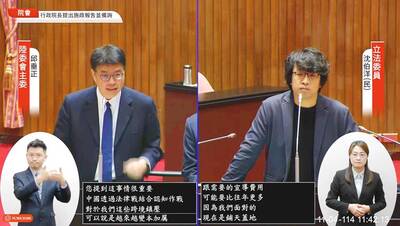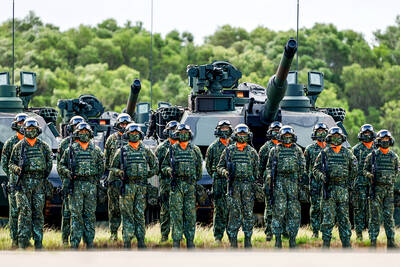China is considering declaring a new air defense identification zone over the South China Sea, according to a Japanese report yesterday, a move likely to fan tensions in an area riven by territorial disputes.
The report comes months after Beijing caused consternation with the sudden declaration of an air defense identification zone above the East China Sea, covering islands at the center of a sovereignty row with Tokyo.
It also comes as countries in the region grow increasingly concerned about what they see as China’s aggressive territorial claims.
Working-level officials in the Chinese air force have drafted proposals for the new zone, which could set the Paracel Islands (Xisha Islands, 西沙群島), also claimed by Taiwan, at its core and spread over much of the sea, the Asahi Shimbun said, citing unnamed sources, including from the Chinese government.
The draft was submitted to senior Chinese military officials by May last year, the daily said.
Beijing claims the South China Sea almost in its entirety, even areas a long way from its shoreline.
The countries surrounding the sea have competing and overlapping claims to the area and are in dispute with Beijing, including over the ownership of islands.
The draft says the zone would at a minimum cover the Paracels, and could go as wide as the majority of the South China Sea, the newspaper said.
Beijing is still deliberating the extent of the zone and considering the timing of an announcement, the paper said.
Japan, South Korea and others reacted with anger in November last year when Beijing unilaterally declared an air defense identification zone in the East China Sea.
China demanded that all aircraft provide flight plans when traversing the area, give their nationality and maintain two-way radio communication, or face “emergency defensive measures.”
The US said it would not comply, and, in what was seen as a challenge to Beijing, promptly flew military planes through it.
The zone covers the Diaoyutai Islands (釣魚台列嶼) claimed by Taiwan, China and Japan — where they are known as the Senkakus.
Beijing’s sudden declaration bolstered claims that China is throwing its growing military weight around. Observers say the establishment of a similar zone in the South China Sea is a likely move for Beijing.
In November last year China’s Hainan Province passed a rule requiring foreign fishing vessels to obtain permission to enter its waters, which it defined as 2 million square kilometers of the sea’s 3.5 million square kilometers. That rule took effect at the beginning of this year, drawing protests from the US, the Philippines and Vietnam.
China announced last month that it would base a 5,000-tonne civilian patrol ship on Woody Island (永興島, Yongxing Island) in the Paracels and begin regular patrols.
In December last year, US Secretary of State John Kerry warned China against any move to declare an air defense zone over the South China Sea.
Additional reporting by staff writer

CALL FOR SUPPORT: President William Lai called on lawmakers across party lines to ensure the livelihood of Taiwanese and that national security is protected President William Lai (賴清德) yesterday called for bipartisan support for Taiwan’s investment in self-defense capabilities at the christening and launch of two coast guard vessels at CSBC Corp, Taiwan’s (台灣國際造船) shipyard in Kaohsiung. The Taipei (台北) is the fourth and final ship of the Chiayi-class offshore patrol vessels, and the Siraya (西拉雅) is the Coast Guard Administration’s (CGA) first-ever ocean patrol vessel, the government said. The Taipei is the fourth and final ship of the Chiayi-class offshore patrol vessels with a displacement of about 4,000 tonnes, Lai said. This ship class was ordered as a result of former president Tsai Ing-wen’s (蔡英文) 2018

‘SECRETS’: While saying China would not attack during his presidency, Donald Trump declined to say how Washington would respond if Beijing were to take military action US President Donald Trump said that China would not take military action against Taiwan while he is president, as the Chinese leaders “know the consequences.” Trump made the statement during an interview on CBS’ 60 Minutes program that aired on Sunday, a few days after his meeting with Chinese President Xi Jinping (習近平) in South Korea. “He [Xi] has openly said, and his people have openly said at meetings, ‘we would never do anything while President Trump is president,’ because they know the consequences,” Trump said in the interview. However, he repeatedly declined to say exactly how Washington would respond in

WARFARE: All sectors of society should recognize, unite, and collectively resist and condemn Beijing’s cross-border suppression, MAC Minister Chiu Chui-cheng said The number of Taiwanese detained because of legal affairs by Chinese authorities has tripled this year, as Beijing intensified its intimidation and division of Taiwanese by combining lawfare and cognitive warfare, the Mainland Affairs Council (MAC) said yesterday. MAC Minister Chiu Chui-cheng (邱垂正) made the statement in response to questions by Democratic Progressive Party (DPP) Legislator Puma Shen (沈柏洋) about the government’s response to counter Chinese public opinion warfare, lawfare and psychological warfare. Shen said he is also being investigated by China for promoting “Taiwanese independence.” He was referring to a report published on Tuesday last week by China’s state-run Xinhua news agency,

‘NOT SUBORDINATE’: Only Taiwanese can decide the nation’s future, and people preserving their democratic way of life is not a provocation, President William Lai said Taiwan does not want China’s “one country, two systems,” and must uphold its freedom and democracy as well as resolve to defend itself, President William Lai (賴清德) said yesterday, rejecting Beijing’s latest bid to bring the country under Chinese control. The president made the remarks while attending a commissioning ceremony for Taiwan’s first battalion of M1A2T Abrams tanks in Hsinchu County’s Hukou Township (湖口). The tanks are made by General Dynamics, a major US defense contractor. China this week said it “absolutely will not” rule out using force over Taiwan, striking a much tougher tone than a series of articles in state media